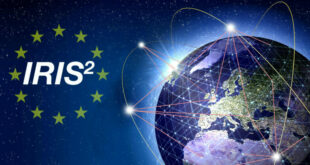As part of the partnership between SpaceWatch.Global and Joint Air Power Competence Centre, we have been granted permission to publish selected articles and texts. We are pleased to present “Using the Space Domain An Intelligence, Surveillance and Reconnaissance Perspective”, originally published in the Joint Air Power Competence Centre Journal 30.
by Major Giuseppe Valentino, IT AF, JAPCC

Introduction
In recent years, Space operations have developed into a remarkable field of strategic interest for technologically advanced nations and military activities. In particular, the discussions surrounding Space functions has increased significantly, as has the awareness of the dependence on Space by NATO member countries. It is commonly accepted in the NATO operational environment that Space is a valuable resource, available for military activities and it’s a domain which must be preserved against possible intrusions aimed at preventing and limiting the use of assets on-orbit.
One of the highest priorities for NATO is Joint Intelligence Surveillance and Reconnaissance (JISR). The importance of JISR was reconfirmed at the 2014 and 2016 Summits held in Newport (Wales) and Warsaw (Poland)1, respectively, and implemented in exercise Unified Vision in 2018.2 One of the most important and crucial aspects in NATO operations is to have Intelligence, Surveillance, and Reconnaissance (ISR) products that are actionable and verified by combining multiple sources. Among the various sources of intelligence available, some of the most effective means of data collection come from Space, in which ISR assets gather information to support operational commanders at all levels. In the Space domain, the next challenge of ISR is to enhance the awareness of Space-based assets and their limitations, optimizing the coordination among NATO nations and personnel training.
Data Collection from Space
From the Balkans’ to the Libyan campaign3, the use of satellites as a source to collect information has been increasingly prioritized and implemented. An example of this is the Low Earth Orbit (LEO) which has been filled by numerous satellites for improving data acquisition in every part of the world and all weather conditions. Indeed, Space Earth Observation (EO) at LEO altitudes can guarantee a high level of revisit time4 in many points on the ground for monitoring targets continuously. In the last decade also civilian companies, sometimes in collaboration with national defence systems, have implemented the sensors’ capabilities to obtain information (data collection and processing) in which the quality of images released are of a high level of resolution and permit opportunities for Intelligence exploitation.
Furthermore, the advanced technological capability of Synthetic Aperture Radar (SAR) and electro-optical sensors combined with Signal Intelligence (SIGINT) satellites and other ISR sources, allows for a vast amount of data, or ‘big data’ transfers. To highlight this point, this process could be viewed as a continuous chain of data fusion that interrelates with other intelligence solutions in order to release persistent and accurate analysis.
Space-based ISR assets can also support targeting. In the latest military campaigns, ISR for targeting has been increased by using satellites to provide accurate information on a single target with a high level of precision, including impact points for attacks. Space-based ISR sensors play an important part in the Battle Damage Assessment process. They are part of the toolbox available to the commander in assessing the structural and functional status of targets.
Apart from the challenges of nationally withheld authority over tasking, NATO must realize the limitations and best practices for exploiting these assets.
A primary aspect of Space-based ISR sensors is to understand the real performance of the sensors and satellites, and how to employ assets in the best way. To accomplish this, a high level of training about tasking management and data entry is needed.
Consider, for example, the passage of a satellite used for intelligence purposes in the planning phase and during a land forces mission. In the aforementioned cases, the revisit time on the target should be taken into account, the availability and the technical limits of the sensor as well as the potential activity of disturbance and countermeasures implemented by the adversaries (i.e. jamming in the data download phase, or the simple camouflage of the area of interest).
Space-based ISR Considerations
ISR is one of the five Space force enhancement functions5 but, contemporarily, it could be the element of supporting capabilities that protects satellite mission execution. In the last decade, new countries have acquired Space-based ISR assets for military and governmental purposes due to their high information contribution, all over the world, so that a certain level of Space services are available in these nations. Furthermore, disruptive technologies6 are increasing day-by-day and could be rapidly used to fill the gap by new capabilities, particularly in the Space domain.
In a new and complex environment in which the ‘globalization and advances in communications are widely believed to enable enemies and adversaries alike to copy NATO countries’ state-of-the-art weapon systems, and possibly even surpass them by developing next-generation weapon systems,’7 Allies should also consider different and alternative sources of data.
It may be necessary for the NATO Intelligence community to focus its collection on the adversaries’ Space capabilities to forewarn of any actions against allied assets in orbit before and during military operations. Satellites might be the first target that a potential adversary tries to engage in offensive action to limit or degrade any NATO use of the Space domain.8 It will be useful to collect information about the enemy’s Space capabilities and dependencies, in order to identify its weak points. As a primary aim, one consideration might be to analyse whether the adversary has redundancy and synergetic system solutions that also include the use of commercial Space providers.
Another key issue is to understand the enemy’s counter-Space capabilities and try to develop the means to counter these or plan for alternative procedures. ISR should not solely rely on satellites but should take into account any sort of limits or influence against on-orbit assets. For instance, the use of images to support targeting evaluation could be disrupted by enemies that have capable counter-Space assets or jamming devices. A factor to be considered is that the oldest generation of satellites does not have equipment for anti-jamming or self-protection.
Further, ISR contributes to improving situational awareness for Space and should be preserved from any intrusion or attack upon military satellites. Many countries have developed anti-satellite capabilities, so the continuous use of satellites during NATO operations is not guaranteed.
The Future of Coordination and Training
Many satellites, and related constellations, have been launched for earth observation, but not all satellites are being used for data collection or are really reliable for Intelligence purposes. More and more satellites are launched for communications, Position, Navigation, and Timing (PNT), Shared Early Warning system (SEW), or to acquire information concerning Meteorology and Oceanography (METOC).
In military operations the use of Space-based ISR asset is vital for supporting NATO commanders from prevention and threat analysis to mission execution. Therefore, in a complex scenario, it may be important to try to identify the effective demand of ISR in the Space domain.
Many nations have Space-based ISR capabilities, but their tasking is still considered to be as a national ‘black-box’. For NATO operations this is a limiting factor for Intelligence collection planning. It means that allied Joint ISR should appreciate their level of awareness of Space-based ISR assets available for tasking. Nevertheless, the critical aspect in NATO’s Intelligence community is not just to have data, but also to exploit the data and transpose gathered data into reliable Intelligence. Unfortunately to analyse collected data from Space, and optimize data fusion, requires highly qualified analysts, with expertise, that at the moment is exclusively part of national capabilities.
This gap could be filled by training and improving continuous education for the Space-based ISR professionals or to introduce coordination elements between Space management assets and Commander’s Critical Information Requirement Management cycle.9
A good step ahead for the Alliance, as evidenced by the last exercise TRIDENT JUPITER, is that NATO has begun to seriously consider Space as a domain playing an important role.
As a future consideration, it is recommended to build up an ISR cell composed of personnel that have expertise in using Space for Intelligence purposes.
Unfortunately, few allied nations have access to Space for intelligence purpose, even if they have commercial support from civilian providers. In this case, it is essential to identify, through lessons learned, what kind of contribution the nations could provide to NATO commanders in terms of expertise. It might be necessary to understand the level of available systems, data information releasing, imagery analysis capabilities or data exploitation to assure a high level of intelligence redundancy. In other words, the use of commercial Space data could improve the Space-based ISR asset resiliency by acquiring new images in the case of limited satellite availability or in cases of limited national contributions. For these reasons, it may be reasonable to develop a NATO autonomous ISR capability to maximize the coordination among nations’ Space assets or build up specific knowledge to combine data collected from other sources.
Concerning the aforementioned topic, it might be reasonable to expand the concept ‘need to share’ by implementing data policy and resource sharing agreements among nations.
Although we have a long way to go, as mentioned in different NATO official documents and publications for training,10 and before executing a military campaign it is important to know the level of intelligence upon which commanders can rely. According to consolidated procedures, the NATO Intelligence Fusion Centre (NIFC)11 may be the point of reference for data collection and exploitation in supporting NATO Intelligence requirements or release basic Intelligence for operational planning. Besides, the level of capabilities required for exploitation should be determined during the force generation Phase to define the level of NATO JISR capabilities correctly.
Conclusion
According to Lieutenant General (ret.) Friedrich W. Ploeger ‘NATO JISR is a key enabling capability to achieve information [superiority] over potential adversaries. ISR is also a key process in air operational planning’12 in which information from satellites will play a noteworthy role to collect data as well as support conventional and unconventional activities.
By contrast, data exploitation from Space might require a higher level of expertise and skilled personnel. For these reasons, training and developing Space-based ISR tasking capabilities to improve the decision-making cycle should be considered in NATO exercise execution,13 to verify the correctness of procedures and training. Accordingly, the Intelligence community should be aware of using Space due to natural, technical, and operational limitations that characterize the uncertainty of domains.
In conclusion, the JISR community should be encouraged to globally perceive the importance of Space,14 be more aware of its advantages and limits, such as satellite performance; set up a new mindset and education for personnel, optimize the process of requesting Space-based ISR products to NATO nations and test new procedures. Collecting data from Space domain might be decisive for maintaining information superiority by increasing a scientific and heuristic model of ISR analysis.
1. ‘Warsaw Summit Communique’, https://www.nato.int/cps/en/natohq/official_texts_133169.htm, last update 27 Mar. 2017.
2. Unified Vision test, https://www.nato.int/cps/en/natohq/news_156098.htm, last update 19 Jun. 2018.
3. Steve and Sonia Stottlemyre, Crisis Mapping Intelligence Information during the Libyan Civili War: an exploratory case study, https://onlinelibrary.wiley.com/doi/abs/10.1002/poi3.9, last update 23 Jan. 2013.
4. The UK Military Space Primer, ‘how often a satellite over-flies a given point on the Earth’s surface’, p. 1-37, the Development, Concepts and Doctrine Center, UK MoD, Jun. 2010.
5. AJP 3.3, edition B, version 1, Apr. 2016, chapter 5.2.2., p. 5-6.
6. Disruptive technology definition: a new technology that completely changes the way things are done, Cambridge dictionary, https://dictionary.cambridge.org/it/dizionario/inglese/disruptive-technology.
7. NATO defence College Policy brief No. 24, Dec. 2019, http://www.ndc.nato.int/.
8. JAPCC 2019 Conference – Theme 2: Defending Space and Cyberspace.
9. Friederich W. Korkish, NATO Gets better Intelligence, IAS reader – Strategy Paper 1-2010, ‘Intelligence collection still follows the traditional loop of direction (what are the issues, often a “strategic” decision), collecting, processing and dissemination (which includes analysing, and estimating, and finally decision making, (CPD&D), based on observe, orient, decide and act (OODA). Problems emerge at every level: Wrong direction, faulty or missing collection, and failures in analysis, wrong estimates, and lack of proper and quick decision making.’
10. NATO Stanag 2555, Intelligence Training; AIntP-11, edition A version 1, Jan. 2016.
11. NATO Intelligence Fusion Centre, Molesworth (UK).
12. Joint Air Power – following the 2016 Warsaw Summit – Urgent Priorities ed. 2017 – chapter IV.
13. Ibid., no. 11.
14. M. Jah, University of Arizona, STO-EN-SCI-292 – Space Surveillance, Tracking, and Information Fusion for Space Domain Awareness, https://www.academia.edu/26553618/Space_Surveillance_Tracking_and_Information_Fusion_for_Space_Domain_Awareness.
Major Giuseppe Valentino

started his career in 1992 joining the Italian Air Force NCO School in Caserta. During his service worked in E.W. group as an Intelligence Analyst and had two tours to Sarajevo (Bosnia-Herzegovina) and was responsible for analysis and production in the Deployed Intelligence Cell.
In 2005, he was engaged as a Force Protection platoon leader in Kosovo as well as supporting other key NATO operations. From 2010 to 2019 he was Section Head of COSMO-SkyMed operations in Italian Defence User Ground Segment (IDUGS). Major Valentino holds an MA with honours, in Political Science Sapienza University of Rome and an MA (level II) in Peacekeeping and Security Studies University Roma Tre, and currently serves as an ISR Subject Matter Expert at the JAPCC.
The original version of JAPCC Journal 30, Space Situational Awareness Together We Stand, Divided We Fall, can be downloaded here JAPCC_J30.
 SpaceWatch.Global An independent perspective on space
SpaceWatch.Global An independent perspective on space




